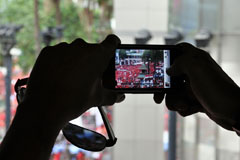For law enforcement authorities, “digital footprinting” may be the next big thing in suspect identification.
The past week provided several new examples of the unintended consequences of new media – all related to the Boston Marathon Bombing case. While many of the side effects I discuss in this blog are negative, In this case, they were mostly positive.
Public supplies thousands of images
Shortly after the bombings near the finish line in this year’s Boston Marathon, law enforcement authorities put out the word through television that they were interested in receiving cell phone pictures and videos from onlookers. Their theory: that the perpetrators would be visible somewhere in the photos.
The public responded. At one point, according to ABC news, the deluge of images pouring into the FBI temporarily crashed their site. So great was the outpouring of support from the public that ABC dubbed the phenomenon “clicktivism.”
Within days, the FBI identified two suspects with the help of facial recognition software to track the thousands of faces in the crowd.
Suspect identification
They correlated the citizen-supplied videos and images with security camera footage from surrounding stores and found two young brothers carrying backpacks large enough to conceal pressure cookers packed with explosives. The color of the backpacks also reportedly matched the color of charred fabric found at the scenes. Through analysis of the images, authorities were also able to identify the brothers at the locations where the bombs exploded.
The authorities then circulated images of “Suspect 1” and “Suspect 2” through mass media. Within minutes, the images went viral and the FBI was able to put names with faces from the leads.
The FBI continued to investigate the suspects’ digital footprints … with the help of social media.
A cell phone reportedly played another key role in tracking down the suspects. As authorities closed in on the suspects, they allegedly carjacked someone to get away. The person who was carjacked reportedly told authorities that the the brothers had confessed responsibility for the bombings to him. The person who was carjacked also left his cell phone in the car when he got away. Using the GPS tracking technology built into the cell phone, authorities closed in on the suspects, shot one and captured the other alive.
Digital footprinting
The remaining suspect is still far from a trial. However, it’s likely in this case that digital footprinting may prove to have the evidentiary value of fingerprinting.
At the top of this post, I said the side effects of digital media were “mostly” positive. Evidently, the Internet also played a negative role. According to news reports, the suspects may have used to Internet to learn how to make the bombs.
Ironically, this one case shows the best and the worst of digital media.

